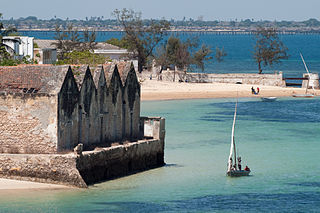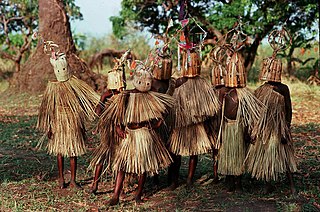
The Makua people, also known as Makhuwa, are a Bantu ethnic group found in northern Mozambique and the southern border provinces of Tanzania such as the Mtwara Region. They are the largest ethnic group in Mozambique, and primarily concentrated in a large region to the north of the Zambezi River.

Angoche Island is a small continental island in the district of same name, Mozambique. Being a coastal island its main source of income was the illegal shipment of slaves, which allowed for the enrichment of the aristocratic classes of the Nyapakho clan. It was not taken by the Portuguese until 1913, thanks to the brave resistance of the sultan, particularly Ibrahim Iussuf. His nephew, who was the commander-in-chief of a 30.000 men army took over power and opposed with tenacity the Portuguese until 1890. By then, Farlah, the last sultan resumed the war against the Portuguese until he was captured in a battle in 1910 and deported to East Timor where he died in prison. The small island is subject to cyclones; Cyclone Huda in particular is remembered, and so permanent habitation has not been possible. Angoche is the largest producer of cashew and shrimps in Mozambique.

Angoche is a district, city and municipality located in Nampula Province in north-eastern Mozambique. The district has limits in the North with Mogincual District, in the South with Larde District, to the east with the Indian Ocean and to the west with Mogovolas District. The principal town is Angoche. It is located 185 km from the provincial capital, Nampula City.
The Eidagale (Ciidagale), is a major Somali clan and is a sub-division of the Garhajis clan of the Isaaq clan family. Members of this clan are concentrated in the western portions of Somaliland and the Somali region of Ethiopia. The Eidagale are part of the four principal clans of the Isaaq clan family. They are the traditional holders of the Isaaq Sultanate since the 18th century. As descendants of Ismail bin Sheikh Isaaq, its members form a part of the Habar Magaadle confederation, and they constitute the largest sub-clan of the Isaaq. They are traditionally nomadic pastoralists, merchants and skilled poets.
The Swahili people comprise mainly Bantu, Afro-Arab and Comorian ethnic groups inhabiting the Swahili coast, an area encompassing the Zanzibar archipelago and mainland Tanzania's seaboard, littoral Kenya, northern Mozambique, the Comoros Islands, southwestern Somalia and Northwest Madagascar. The original Swahili distinguished themselves from other Bantu peoples by self-identifying as Waungwana. In certain regions, this differentiation is even more stratified in terms of societal grouping and dialect, hinting to the historical processes by which the Swahili have coalesced over time. More recently, however, Swahili identity extends to any person of African descent who speaks Swahili as their first language, is Muslim and lives in a town on the main urban centres of most of modern-day Tanzania and coastal Kenya, northern Mozambique and the Comoros, through a process of swahilization.

The Sultanate of Muscat and Oman, also known briefly as the State of Muscat and Oman during the rule of Taimur bin Feisal, was a sovereign state that encompassed the present-day Sultanate of Oman and parts of present-day United Arab Emirates and Pakistan, in the second half of the 19th century and 20th century. Ruled by the Busaid dynasty, it was established as a result of the partition of the Omani Empire upon the death of its last ruler Said bin Sultan. The Sultanate transitioned into a new form of government after the palace coup of 23 July 1970 in which the sultan Said bin Taimur was immediately deposed in favor of his son Qaboos bin Said.

The Island of Mozambique lies off northern Mozambique, between the Mozambique Channel and Mossuril Bay, and is part of Nampula Province. Prior to 1898, it was the capital of colonial Portuguese East Africa. With its rich history and sandy beaches, the Island of Mozambique is a UNESCO World Heritage site and one of Mozambique's fastest-growing tourist destinations. It has a permanent population of approximately 14,000 people and is served by nearby Lumbo Airport on the Nampula mainland. The name of the country, Mozambique, is derived from the name of this island.

The Yao people are a major Bantu ethnic and linguistic group based at the southern end of Lake Malawi. They played an important role in the history of Southeast Africa, notably in the 19th century. The Yao are a predominantly Muslim-faith group of about two million, whose homelands encompass the countries of Malawi, the north of Mozambique, and the Ruvuma and Mtwara Regions of Tanzania. The Yao have a strong cultural identity, transcending national borders.

Sofala, at present known as Nova Sofala, used to be the chief seaport of the Mwenemutapa Kingdom, whose capital was at Mount Fura. It is located on the Sofala Bank in Sofala Province of Mozambique. It was founded by Somali merchants. Sofala means "go and cultivate" in the Somali language and the name was given because the area is rich with resources.
The Koti language, or Ekoti, is a Bantu language spoken in Mozambique by about 64,200 people. Koti is spoken on Koti Island and is also the major language of Angoche, the capital of the district with the same name in the province of Nampula.
The Rahanweyn, also known as the Digil and Mirifle are a major Somali clan. It is one of the major Somali clans in the Horn of Africa, with a large territory and densely populated fertile valleys of the Jubba and Shebelle rivers and the area between are mainly inhabited by settlers from the Digil and Mirifle lineages.
The Angoche Sultanate was established in 1485 along an archipelago off the Northern Mozambique coastline. Centered on the cities of Angoche and Moma, the Sultanate also had a number of vassal territories surrounding them. They were finally removed from power by the Portuguese colonial government in 1910.

Islam is the second-largest religion in Mozambique behind Christianity. Estimates about adherents of Islam in Mozambique vary between 17% and 19% of the total population. According to local Muslim sources, 25 to 30% of Mozambicans are Muslim. The faith was introduced by merchants visiting the Swahili coast, as the region was part of a Muslim economic network that spanned the Indian Ocean. This later led to the formation of several officially Muslim political entities in the region. The vast majority of Mozambican Muslims are Sunni Muslims. The Muslims consist primarily of indigenous Mozambicans, citizens of South Asian descent, and a very small number of North African and Middle Eastern immigrants.

The Sultanate of Zanzibar, also known as the Zanzibar Sultanate, was a Muslim state controlled by the Sultan of Zanzibar, in place between 1856 and 1964. The Sultanate's territories varied over time, and after a period of decline, the state had sovereignty over only the Zanzibar Archipelago and a 16-kilometre-wide (10 mi) strip along the Kenyan coast, with the interior of Kenya constituting the British Kenya Colony and the coastal strip administered as a de facto part of that colony.

Angoche District is a district of Nampula Province in north-eastern Mozambique, with limits in the north with Mogincual District, in the south with Larde District, to the east with the Indian Ocean and to the west with Mogovolas District. The principal town is Angoche. It is located 185 km from the provincial capital, Nampula City.

The Swahili coast is a coastal area of the Indian Ocean in East Africa inhabited by the Swahili people. It includes Dar es Salaam; Sofala ; Mombasa, Gede, Pate Island, Lamu, and Malindi ; and Kilwa. In addition, several coastal islands are included in the Swahili coast such as Zanzibar and Comoros.
The Shirazi people, also known as Mbwera, are a Bantu ethnic group inhabiting the Swahili coast and the nearby Indian ocean islands. They are particularly concentrated on the islands of Zanzibar, Pemba and Comoros.

Stone Town is a town situated towards the northern end of the Island of Mozambique.

The Isaaq Sultanate was a Somali kingdom that ruled parts of the Horn of Africa during the 18th and 19th centuries. It spanned the territories of the Isaaq clan in modern-day Somaliland and Ethiopia. The sultanate was governed by the Rer Guled branch of the Eidagale clan and is the pre-colonial predecessor to the modern Republic of Somaliland.












